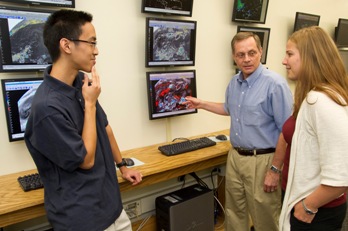- Home
- /
- News and Events
- /
- News Releases
- /
- Release
- /
UAlbany Research Team Part of NASA Hurricane Study
Research effort aims to better understand how tropical storms form and develop into major hurricanes
Contact(s): Catherine Herman (518) 956-8150
 |
(L-R) Graduate student Leon Nguyen, Professor John Molinari and graduate student Diana Thomas. (Photo Mark Schmidt) |
ALBANY, N.Y. (August 27, 2010) -- A team of University at Albany students and faculty will travel to Ft. Lauderdale, Fla. from August 29-September 11 to participate in a hurricane study coordinated by theNational Aeronautics and Space Administration (NASA). The Genesis and Rapid Intensification Processes Experiment (GRIP) is scheduled to take place during the height of Atlantic hurricane activity.
According to NASA, hurricane damages in the U.S. have risen exponentially in recent decades. Due to increased growth in coastal communities, it can cost as much as $1 million per square mile for evacuation preparations alone, not including loss of revenues, actual cost of hurricane damage, or the loss of life.
As part of the GRIP experiment the team will focus on how hurricanes form and what causes their rapid intensification. Intensification is one separate phase of hurricane development in which a weak tropical storm progresses into a hurricane. The study hopes to enable scientists to give more advance warning to vulnerable communities. During the GRIP experiment, the students will collect data on the hurricane�s structure, dynamics and motion, which will assist in decreasing the size of the evacuation area while increasing the warning time to these areas.
"We are pleased to work with NASA on the GRIP experiment. Ultimately, this work will help us to understand and predict hurricane formation, which remains an unsolved scientific problem," said John Molinari, UAlbany professor of atmospheric and environmental sciences. "Many times all of the ingredients are there -- warm water, persistent intense rainfall, and a pre-existing low pressure area -- yet development does not occur, or is delayed for 24-48 hours. We want to understand what processes delay or even prevent tropical cyclone formation, as well as what brings it about."
The three students involved in the GRIP experiment are Diana Thomas of Lillington, N.C., Leon Nguyen of Fresno, Calif., and Matt Janiga of Chicago, Ill.
The University at Albany Department of Atmospheric and Environmental Sciences is one of the nation's premier research enterprises. In addition to GRIP, the University is involved in other nationally funded storm experiments, including the Pre-Depression Investigation of Cloud-systems in the Tropics (PREDICT) - funded by the National Science Foundation and NASA, and the Intensity Forecast Experiment (IFEX) led by the National Oceanic and Atmospheric Administration (NOAA) based at the Hurricane Research Division.
![]() For more news, subscribe to UAlbany's RSS headline feeds
For more news, subscribe to UAlbany's RSS headline feeds
Educationally and culturally, the University at Albany-SUNY puts "The World Within Reach" for its 18,000 students. An internationally recognized research university with 58 undergraduate majors and 128 graduate degree programs, UAlbany is a leader among all New York State colleges and universities in such diverse fields as public policy, nanotechnology and criminal justice. With a curriculum enhanced by 300 study-abroad opportunities, UAlbany launches great careers. For more information about this globally ranked University, visit www.albany.edu. For UAlbany's extensive roster of faculty experts, visit www.albany.edu/news/experts.shtml.


